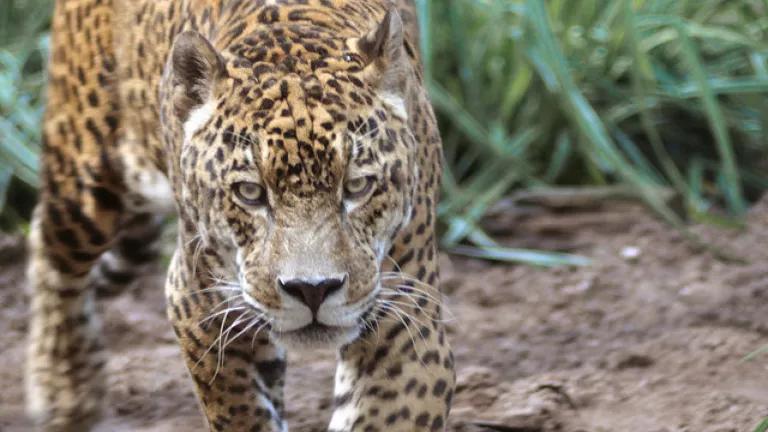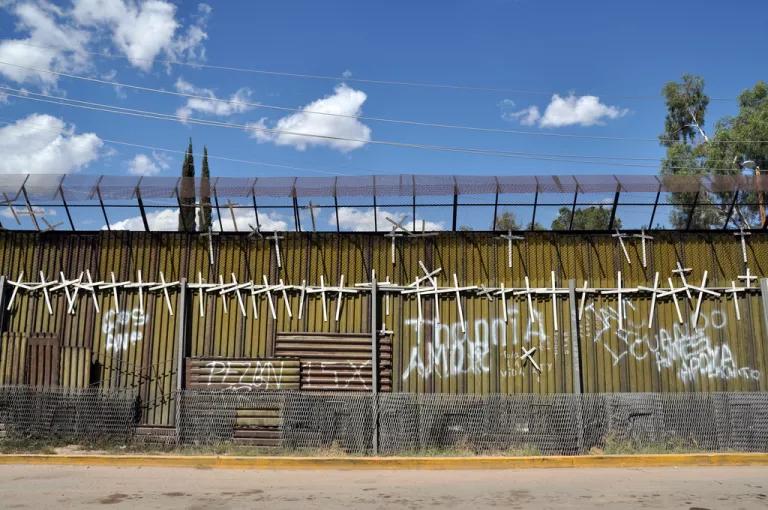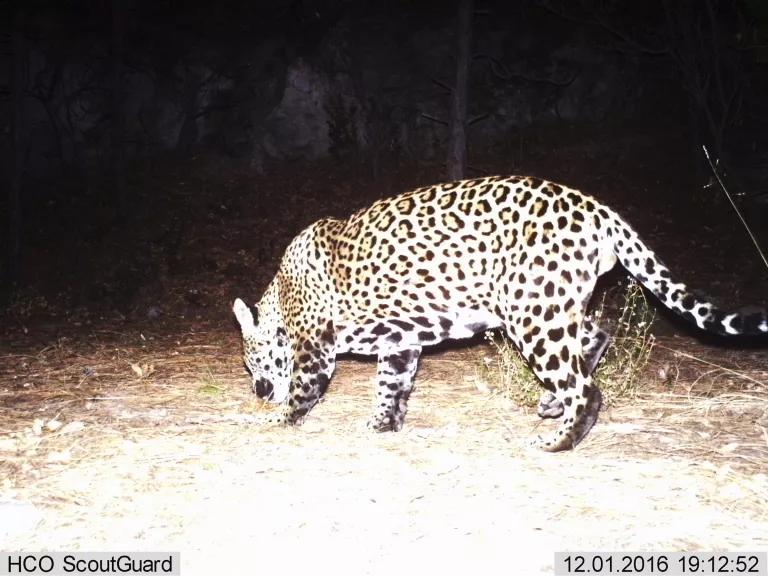El Jefe the Jaguar Is Also Not a “Bad Dude”
Another reason to oppose President Trump’s proposed border wall with Mexico: It would be devastating for wildlife.

Just about a year ago, a YouTube sensation emerged from an unlikely place: the rugged wilderness of Arizona’s Santa Rita mountains. He made just one video, but those 41 seconds of footage—compiled from remote motion-sensor cameras—were enough to solidify his claim to fame as the only known wild jaguar living in the United States. A group of Tucson schoolkids won a nationwide naming contest, christening the big cat El Jefe, Spanish for “The Boss,” a nod to his apex predator status and Mexican heritage.
El Jefe, however, has recently become headline worthy for another reason. On January 25, our newly elected president signed an executive order calling for “the immediate construction of a physical wall on the southern border.” Now our beloved boss cat represents the threat that barrier would pose to wildlife.
President Trump’s clamorous demand to build a wall along the nearly 2,000 miles we share with Mexico has, of course, sparked a litany of objections—it’s offensive, for one, and it would be costly, ineffective, and infeasible, to name just a few more. Individuals and organizations ranging from the mayor of the border town of Laredo, Texas, to the American Civil Liberties Union to the pope have spoken out against the order. Clearly, the wall’s negative impact on wildlife is only one of many legitimate concerns, but it’s significant nonetheless.
Trump’s wall could affect anything from bighorn sheep to wolves to javelinas, but El Jefe’s story is a powerful case study. A hundred years ago, a jaguar’s stealthy presence in Arizona would have been unremarkable. In the United States, the species’ historic range included a swath from California to Texas—possibly stretching as far east as Louisiana. But by the mid-1900s, federal predator-control programs had pretty much eliminated jaguars from the country. A hunter in 1913 could collect a $5 bounty per jaguar, equivalent to about $123 today. Mexico is still home to some 4,000 individuals, including 50 to 100 in the northern state of Sonora, from where El Jefe likely hails.
Walking for just a few days, a male Sonoran jaguar can easily wander into Arizona. Conservationists haven’t given up hope that the cats might come back and restore their ranks north of the border. “The landscape really is not whole without jaguars,” says Randy Serraglio, a southwest conservation advocate for the Center for Biological Diversity. “They belong here.” After several sightings of the spotted cat, the U.S. Fish & Wildlife Service (FWS) added it to the Endangered Species List in 1997. Hunters first spotted El Jefe in November 2011.
Female jaguars, however, don’t typically have the same level of wanderlust. El Jefe hasn’t been seen in recent months, and it’s possible that he has returned to Sonora to find a Señora El Jefe (or La Jefa?) to mate with. Because males alone can’t reestablish a breeding population—the future is female, if you will—biologists treat the possibility of a jaguar comeback on U.S. soil with varying degrees of optimism. “If there’s going to be a population recolonized in the States, then we really have to expand the population that’s south of the border,” says Howard Quigley, executive director of the jaguar program at Panthera, a big cat conservation group.
One thing is certain, however: As slim as the chance for jaguars to reestablish themselves here may be, a wall would prevent it entirely. “If somehow Trump is able to realize his fantasy of walling off the U.S.-Mexico border, it would be the end of jaguars in the United States,” Serraglio says. “They would never have a chance to recover here.”
A border wall could also be devastating to the survival of northern Mexico’s fragile jaguar population. Habitat fragmentation, development, and hunting threaten the long-term survival of the species both in Sonora and throughout its range, which extends south to northern Argentina. Throughout the Americas, an estimated 30,000 remaining wild jaguars occupy just 46 percent of their historic range.
In fact, those threats in northern Mexico were part of the reasoning behind the FWS’s decision to designate 764,207 acres of critical jaguar habitat in Arizona and New Mexico. Its 2014 rule reads, “Critical habitat in the United States contributes to the jaguar’s persistence and recovery across the species’ entire range. . .therefore, maintaining connectivity to Mexico is essential to the conservation of the jaguar.”
Trump’s great divider would hurt many other endangered species that straddle the border, too. The recovery plan for the ocelot, which has been under federal protection since 1982, includes connecting the populations in Texas and Mexico. And after rebounding from the brink of extinction, an estimated 160 Sonoran pronghorns remain in the States, with 240 or so more living in Mexico. They need to get together to make more pronghorns, the speediest land animals in North America. Our two countries have also been working together for years to recover the Mexican gray wolf, the most endangered subspecies of wolf in the world.
Many wildlife populations depend on the ability to roam, whether to find a love connection, to migrate, or to mix genes between isolated populations. Serraglio cited one particular herd of bison that crosses the border nearly every day to go between a preferred pasture on one side and a favorite watering hole on the other. “There are all kinds of reasons why animals need to move around on the landscape in order to be biologically healthy,” Serraglio says. “And all that would be disrupted by the border wall.”

Federal projects usually require an extensive environmental impact statement before they can get the green light, but there’s reason to think that the Trump administration might skip that step. Before signing the Secure Fence Act of 2006, which allowed the United States to build 700 miles’ worth of barriers along the Mexican border, then-President George W. Bush enacted the REAL ID Act. Section 102 of that legislation allows the secretary of homeland security to waive all local, state, and federal laws deemed an impediment to construction along U.S. borders. The former secretary, Michael Chertoff, subsequently used it to override the Endangered Species Act and other environmental protections.
As a result of these waivers, the existing walls have impinged on communities that don’t want them and triggered environmental problems experts could have foreseen—if they had been consulted. The San Pedro Riparian National Conservation Area, one of the most biologically diverse areas in the country, is now home to two miles of border fencing in addition to hundreds of species of birds, mammals, fish, amphibians, and reptiles. According to the Sierra Club, in addition to blocking wildlife, construction there desecrated 69 Native American burial sites and accelerated erosion and sedimentation in the riverbed.
Even winged animals could feel the effects of fragmentation. A 2009 study found that the ferruginous pygmy owl, which got off the FWS Endangered Species List only 11 years ago, rarely flies higher than 4.5 feet off the ground; the average height of the fencing now bisecting its habitat is 13 feet.
“One of the big issues in wildlife conservation is to prevent fragmentation,” Panthera’s Quigley says. “As soon as you start fragmenting populations—whether it’s with a road, or with a huge plantation of oil palm, or whatever it is—then you start seeing the demise of not only that species, but the system and its multiple interactions.”
A month after the election, the Arizona Game and Fish Department and FWS announced that a trail camera in the Huachuca Mountains had snapped a shot of what seems to be a second male jaguar on U.S. soil. With such uncanny timing, it’s almost as if this big cat showed up to remind the president-elect that he’s not the only new boss in town.

This article was originally published on onEarth, which is no longer in publication. onEarth was founded in 1979 as the Amicus Journal, an independent magazine of thought and opinion on the environment. All opinions expressed are those of the authors and do not necessarily reflect the policies or positions of NRDC. This article is available for online republication by news media outlets or nonprofits under these conditions: The writer(s) must be credited with a byline; you must note prominently that the article was originally published by NRDC.org and link to the original; the article cannot be edited (beyond simple things such grammar); you can’t resell the article in any form or grant republishing rights to other outlets; you can’t republish our material wholesale or automatically—you need to select articles individually; you can’t republish the photos or graphics on our site without specific permission; you should drop us a note to let us know when you’ve used one of our articles.

One of Our Most Important Environmental Laws Just Turned 50—Cue Trump Attacking It
Why the EPA Needs Another William Ruckelshaus (1932–2019)
Bureau of Land Management to D.C. Employees: Go West or Get Lost